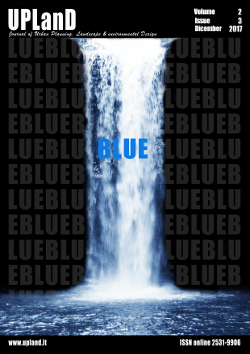Community Engagement in an Urban Daylighting Project: A Case Study of a Salt Lake City Creek
Main Article Content
Abstract
During the industrialization era in the U.S., most waterways in urban areas were buried underground. Daylighting, the process of resurfacing and restoring buried aquatic systems, has grown as a planning practice. This practice can bring to communities environmental, economic, and social benefits—making cities more sustainable and livable. City Creek in Salt Lake City will be used as a case study of a future daylighting project in Euclid, a minority and low income neighborhood. In particular, this paper will highlight planning and locally-driven efforts to raise awareness among residents on the importance of conserving and restoring stream ecosystems. The article will discuss what community members involved in a visioning process would like to see in the development of a much-needed recreational trail and why it matters that City Creek becomes a vital community asset. Ultimately, this paper seeks to empower communities to plan and implement daylighting projects at the local level.
Downloads
Article Details

This work is licensed under a Creative Commons Attribution-NonCommercial-NoDerivatives 4.0 International License.
Authors who publish with this journal agree to the following terms:- Authors retain copyright and grant the journal right of first publication with the work simultaneously licensed under a Creative Commons Attribution License that allows others to share the work with an acknowledgement of the work's authorship and initial publication in this journal.
- Authors are able to enter into separate, additional contractual arrangements for the non-exclusive distribution of the journal's published version of the work (e.g., post it to an institutional repository or publish it in a book), with an acknowledgement of its initial publication in this journal.
- Authors are permitted and encouraged to post their work online (e.g., in institutional repositories or on their website) prior to and during the submission process, as it can lead to productive exchanges, as well as earlier and greater citation of published work (See The Effect of Open Access).
References
Bernhardt, Emily S., and Margaret A. Palmer. “Restoring Streams in an Urbanizing World.” Freshwater Biology 52, no. 4 (April 1, 2007): 738–51. doi:10.1111/j.1365-2427.2006.01718.x.
Brun, Alexandre, Llewella Maléfant, Hervé Caltran, and Jérôme Albertin. “Recreating Nature in Cities: A Research Program for the River’s Renaturation in the Greater Lyon.” UPLanD - Journal of Urban Planning, Landscape & Environmental Design 2, no. 1 (April 29, 2017): 187–98. doi:10.6092/2531-9906/5147
Cooter, William S. “Clean Water Act Assessment Processes in Relation to Changing U.S. Environmental Protection Agency Management Strategies.” Environmental Science & Technology 38, no. 20 (October 1, 2004): 5265–73. doi:10.1021/es030690h.
Elmore, A.J., and S.S. Kaushal. “Disappearing Headwaters: Patterns of Stream Burial due to Urbanization.” Frontiers in Ecology and the Environment, no. 6 (2008): 308–12. doi:10.1890/070101
Freeman, M.C., C.M. Pringle, and C.R. Jackson. “Hydrologic Connectivity and the Contribution of Stream Headwaters to Ecological Integrity at Regional Scales.” Journal of the American Water Resources Association 43 (2007): 5–14. doi:10.1111/j.1752-1688.2007.00002.x
Lee, Yong-Ki, Choong-Ki Lee, Joowon Choi, Seol-Min Yoon, and Robert John Hart. “Tourism’s Role in Urban Regeneration: Examining the Impact of Environmental Cues on Emotion, Satisfaction, Loyalty, and Support for Seoul’s Revitalized Cheonggyecheon Stream District.” Journal of Sustainable Tourism 22, no. 5 (July 4, 2014): 726–49. doi:10.1080/09669582.2013.871018.
Love, Ron. “Daylighting Salt Lake’s City Creek: An Urban River Unentombed Environmental Law Journal Symposium Edition: Outside Article.” Golden Gate University Law Review 35 (2005): 343–76.
Lund, Ken. City Creek Park Near Temple Square, Salt Lake City, Utah Ken Lund [CC BY 2.0 (Http://Creativecommons.org/Licenses/By/2.0)], 2005. Flickr. https://www.flickr.com/photos/kenlund/68885492.
Moccia, F.D., and Sgobbo, A. (2013), “Flood hazard: Planning approach to risk mitigation”, WIT Transactions on The Built Environment, 134, pp. 89-99. doi:10.2495/SAFE130091
Nishioka, Kyle. Cheong Gye Cheon 2) [CC BY 2.0 (Http://Creativecommons.org/Licenses/By/2.0)], via Wikimedia Commons, 2007. Flickr. https://commons.wikimedia.org/wiki/File:Korea-Seoul-Cheonggyecheon-02.jpg.
Pinkham, R. “Daylighting: New Life for Buried Streams.” Old Snowmass, Colorado.: Rocky Mountain Institute, 2000.
Pinkham, R., R. Serrano, E. Kwanza, and P. Krishna. “Three Rivers Second Nature Stream Restoration and Daylighting Report.” Carnegie Mellon. Pittsburgh, PA.: Studio for Creative Inquiry, 2001.
Salt Lake City Government. “Euclid: Small Area Master Plan,” 2004.
Salt Lake City Planning Division. “North Temple Boulevard.” Salt Lake City Planning Division, 2010. http://www.slcdocs.com/Planning/MasterPlansMaps/NTMP.pdf.
Seven Canyons Trust. “Trust 100 Years of Daylighting.” Salt Lake City, UT: University of Utah, City + Metropolitan Planning Program, 2014. http://sevencanyonstrust.org/100-years-of-daylighting/. Commonshttps://commons.wikimedia.org/wiki/File:City_Creek_at_City_Creek_Center,_SLC,_UT.JPG.
Sgobbo, A. (2016), “Recycling, waste management and urban vegetable gardens”, WIT Transactions on Ecology and The Environment, 202, pp. 61-72. doi:10.2495/WM160071
Tira, M., Giannouli, I., Sgobbo, A., Brescia, C., Cervigni, C., Carollo, L., and Tourkolias, C. (2017), “INTENSSS PA: a systematic approach for INspiring Training ENergy-Spatial Socioeconomic Sustainability to Public Authorities”, UPLanD-Journal of Urban Planning, Landscape & environmental Design, 2(2), pp. 65-84. doi:10.6092/2531-9906/5258
Walsh, Christopher J., Allison H. Roy, Jack W. Feminella, Peter D. Cottingham, Peter M. Groffman, and Raymond P. Morgan. “The Urban Stream Syndrome: Current Knowledge and the Search for a Cure.” Journal of the North American Benthological Society 24, no. 3 (September 1, 2005): 706–23. doi:10.1899/04-028.1

